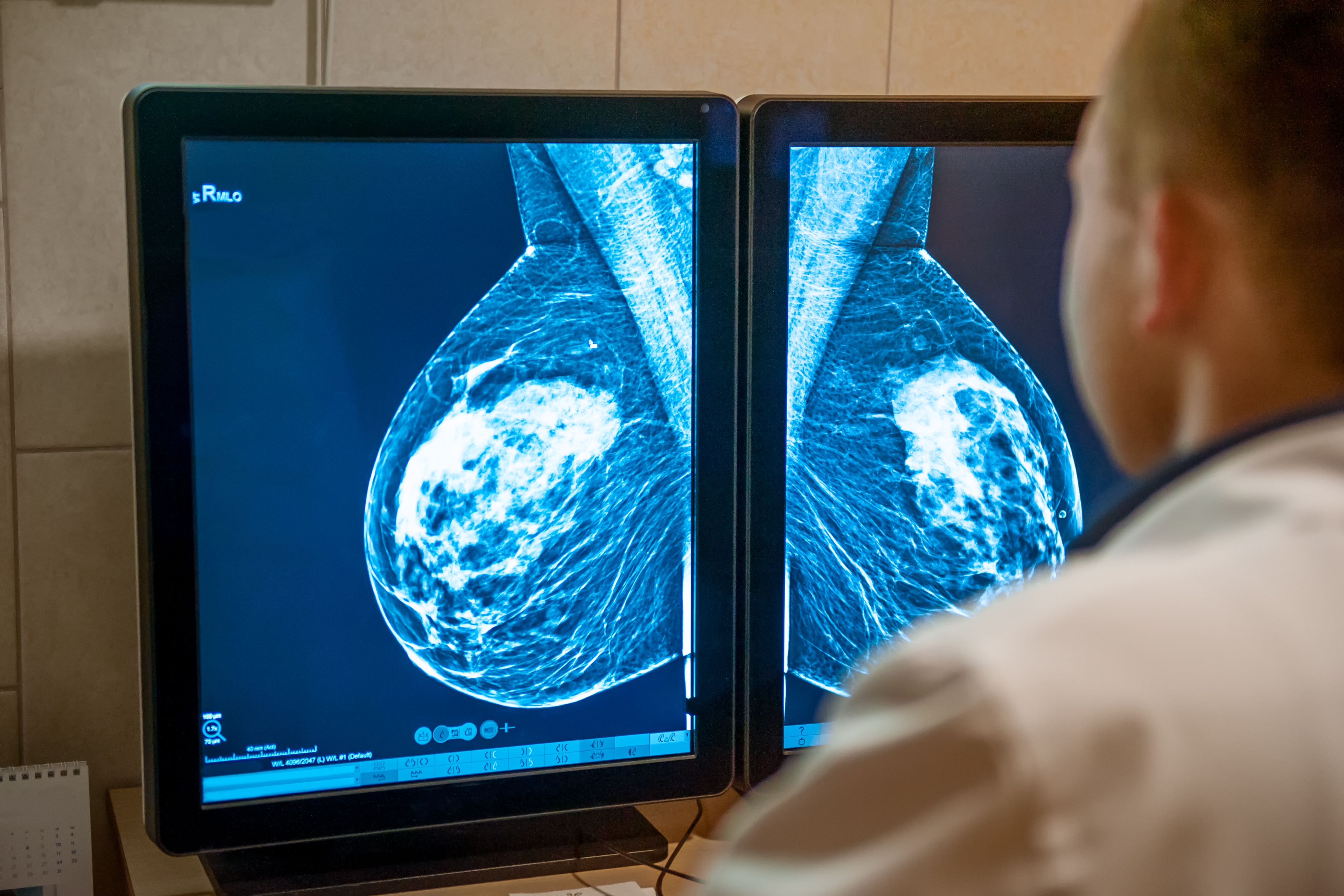Abemaciclib Plus ET Upholds Efficacy/Safety Over Four Years in HR+, HER2– eBC
Results from an age group analysis of the monarch E trial reveal continued efficacy and safety with the experimental regimen, abemaciclib plus endocrine therapy.
Erika P. Hamilton, MD

Patients with hormone receptor (HR)–positive, HER2-negative, high-risk early breast cancer had a sustained clinically meaningful absolute risk reduction in invasive disease-free survival (iDFS) and distant relapse-free survival (DRFS) on treatment with abemaciclib (Verzenio) plus endocrine therapy (ET), regardless of age, according to an analysis of the monarchE trial (NCT03155997).1
The 4-year iDFS rate for patients aged 65 years or older, as presented at the 2023 ASCO Annual Meeting, was 82.0% in the received abemaciclib plus ET arm (n = 437) vs 76.8% for patients who received ET alone (n = 413) for an absolute magnitude of benefit of 5.2% (HR, 0.767; 95% CI, 0.556-1.059). For patients who were younger than 65 years, the 4-year iDFS rates were 86.5% with abemaciclib and ET (n = 2371) vs 79.8% with ET alone (n = 2416) for an absolute magnitude of benefit of 6.7% (HR, 0.646; 95% CI, 0.554-0.753).1
Findings from the landmark, 4-year analysis were previously presented at the 2022 San Antonio Breast Cancer Congress and published in Lancet Oncology.2 At a median follow-up of 42 months, a 34% reduction in the risk of developing an iDFS event was reported with adjuvant abemaciclib plus endocrine therapy (n = 2808) vs endocrine therapy alone (n = 2829; HR, 0.664; 95% CI, 0.578-0.762; nominal P < .0001). The 48-month iDFS rates were 85.8% vs 79.4%, with and without abemaciclib, respectively.2
“For our patients that were 65 years of age or greater, and consistent results were observed in cohort 1,” Erika P. Hamilton, MD, said in a presentation of the data. “For patients with hormone receptor–positive, HER2-negative, high-risk, early breast cancer adjuvant abemaciclib plus ET showed consistent treatment benefit across age subgroups with clinically meaningful absolute risk reduction in both iDFS as well as DRFS rates observed in both younger and older patients.” Hamilton is the director of Breast and Gynecologic Cancer Research at Sarah Cannon Research Institute in Nashville, Tennessee.
In terms of DRFS an absolute magnitude of benefit of 6.2% was observed in the younger patient population and 4.6% benefit was observed in the older population.1 Specifically, the 4-year iDFS rates in the younger patient population were 88.8% abemaciclib plus ET vs 82.6% with ET alone (HR, 0.647; 95% CI, 0.548-0.764). In older patients the 4-year DRFS rate was 86.1% with the addition of abemaciclib to ET vs 81.5% with ET alone (HR, 0.748; 95% CI, 0.520-1.077).1
In the intention-to-treat population 4-year DRFS rates was 88.4% with adjuvant abemaciclib and ET vs 82.5% with ET alone for a 34% reduction in the risk of developing a DRFS event (HR, 0.659; 95% CI, 0.567-0.767).2
monarchE was a phase 3 trial that randomly assigned patients to receive 150 mg of adjuvant abemaciclib twice daily for 2 years in addition to standard-of-care ET or ET alone. “The objective of this analysis of monarchE was to explore the efficacy and safety of adjuvant abemaciclib and the subgroup of older patients [who] were enrolled,” Hamilton said. “All patients went on to receive 3 to 8 years of standard single-agent ET per patient and physician decision. All patients are off abemaciclib with a median follow up of 42 months. Efficacy, safety, and patient-reported outcome analyses were conducted in 2 age groups, those patients who were [younger] than 65 years and those that were 65 years or greater. Patients who were [older] than 75 years made up only 3% of the study population, which really precluded a detailed outcome analysis in this subgroup.”
The baseline characteristics for the intention-to-treat population were well balanced with a median age of 51 years (range, 44-60).2 Baseline factors relevant to this analysis included pathologic tumor size, number of positive lymph nodes, histopathological grade, prior neoadjuvant chemotherapy, and ECOG performance status.
Most younger patients had tumor size of 20 mm to less than 50 mm (48%), at least 4 positive lymph nodes (59%), G2 disease (49%), had received neoadjuvant chemotherapy (97%), and an ECOG performance status of 0 (86%). Older patients mostly had tumor size of 20 mm to less than 50 mm (57%), 4 or more positive lymph nodes (64%), and G2 disease (52%). Hamilton called attention to the fact that fewer older patients had neoadjuvant chemotherapy (82%) and ECOG performance status of 0 (77%), which was expected.
“Similarly, in terms of patients who had 4 or more baseline pre-existing comorbidities, only 33% of our younger patients experienced this [compared with] more than half at 51% of our older patients,” Hamilton said. Further, among treated patients 95% of older patients (n = 840) received aromatase therapy as their initial endocrine therapy compared with 64% of younger patients, more of whom received tamoxifen.1
Adverse event (AE) rates were similar between age groups, Hamilton noted. “In terms of neutropenia, ALT increase, venous thromboembolism [VTE], or ILD [interstitial lung disease] there were not even numerical increases for older patients compared with younger patients,” she said.
Image Credit: © okrasiuk - www.stock.adobe.com

Clinically relevant AEs for the overall population (n = 2791), younger patients (n = 2361), and older patients (n = 430), were reported as follows grade 1 diarrhea (45% vs 46% vs 37%), grade 2 diarrhea (31% vs 31% vs 30%), grade 3 diarrhea (8% vs 7% vs 12%), grade 1 fatigue (23% vs 23% vs 21%), grade 2 fatigue (15% vs 14% vs 20%), grade 3 fatigue (3% vs 2% vs 6%), grade 1/2 neutropenia (26% vs 27% vs 22%), grade 3 or higher neutropenia (20% vs 20% vs 19%), grade 1/2 ALT increase (10% vs 10% vs 7%), grade 3 or higher ALT increase (3% vs 3% vs 3%), any-grade VTE (3% vs 2% vs 3%), grade 3 or higher VTE (1% vs 1% vs 1%), any-grade ILD (3% vs 3% vs 3%), and grade 3 or higher ILD (all less than 1%).1
“In terms of diarrhea, any-grade diarrhea was actually 5% less common in older patients than younger patients,” Hamilton noted. “However, grade 3 or higher severe diarrhea was 5% more frequent…. Despite this dose adjustments were more common in older patients with 42% of the younger patients [having] dose reductions, whereas 55% of the patients 65 years of age or older did.” She added that discontinuations were more than double in older patients at 38% compared with 15% for younger patients. “Over half of patients who discontinued on study did so without attempting a dose reduction, and this was across both age groups.”
Patients who were treated with abemaciclib who required a dose reduction were placed into 3 equal-size subgroups according to dose intensity (0%-66% [ n = 926]; 66%-93% [n = 928]; and ≥ 93% [n = 927]). The 4-year iDFS rates were similar across the groups at 87.1%, 86.4%, and 83.7%, respectively.1
“Based on this, I would suggest that in order to maintain treatment compliance—particularly seeing that over half of the patients who discontinued abemaciclib did so without utilizing a dose reduction—that older patients should be counseled about symptom management and monitored closely for AEs that should prompt a dose modification,” Hamilton said.
Finally, she noted that quality of life was preserved in both age groups during the 2-year treatment period.
“These data support the use of adjuvant abemaciclib across age groups and can be used to counsel patients about expectations of treatment experience, and also the safety and utilizing dose reductions if needed,” she concluded.
REFERENCES:
1. Hamilton EP, Kim JH, Eigeliene N, et al. Efficacy and safety results by age in monarchE: adjuvant abemaciclib combined with endocrine therapy (ET) in patients with HR+, HER2, node-positive, high-risk early breast cancer (EBC). J Clin Oncol. 2023;41(suppl 16):501. doi:10.1200/JCO.2023.41.16_suppl.501
2. Johnston SRD, Toi M, O’Shaughnessy J, et al; monarchE Committee Members. Abemaciclib plus endocrine therapy for hormone receptor-positive, HER2-negative, node-positive, high-risk early breast cancer (monarchE): results from a preplanned interim analysis of a randomised, open-label, phase 3 trial. Lancet Oncol. 2023;24(1):77-90. doi:10.1016/S1470-2045(22)00694-5